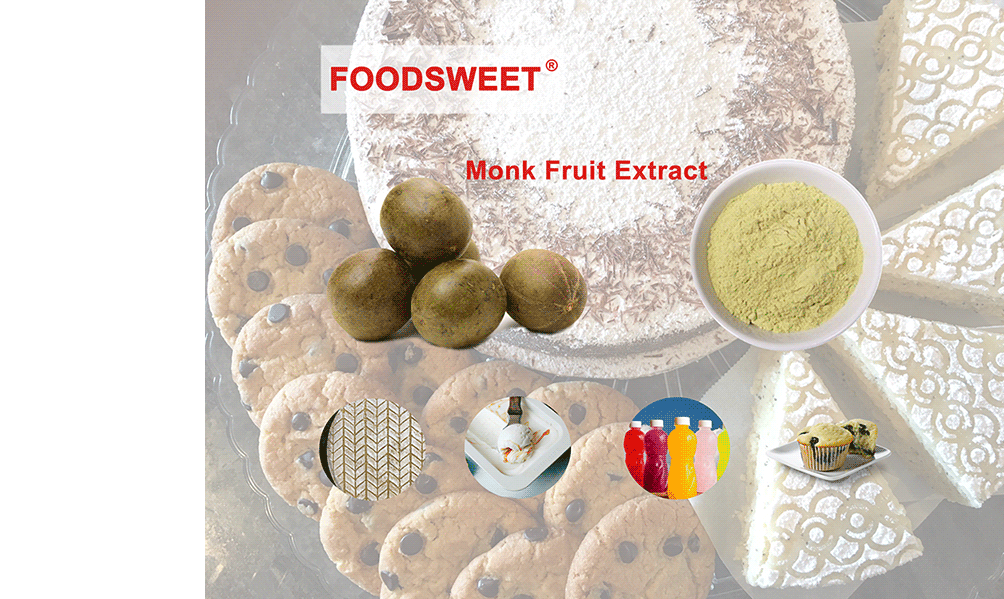FOODCHEM
Share:

新闻动态
Natural Sweeteners ___ Monk Fruit Extract
Monk Fruit Extract also identified as Siraitia grosvenorii Swingle (Luo Han Guo or Luo Han Kuo) fruit extract (SGFE)
Why of Interest to Monk Fruit Extract ?
Monk fruit extract is a second high intensity sweetener, along with stevia, that can be considered “natural,” has FDA-notified GRAS status in the USA, is primarily used for sweetening and is commercially available in the USA among other countries. There are other natural high intensity sweeteners such as brazzein, thaumatin and the mabinlins, but they don’t meet one or more of these criteria.
What is its Source?
Monk fruit (luo han guo) is a melon grown in China. The commercial cultivation of monk fruit is said to be labor intensive since it requires hand pollination and selective breeding. The fruit’s pulp contains sweet compounds called mogrosides, which are roughly one percent of the fruit pulp. One mogroside in particular, mogroside V, provides a desired sweet characteristic.
The commercial ingredient is obtained by mechanically crushing or shredding fruit which is then infused (extracted) with hot water. Further purification generally involves centrifugation and ultrafiltration to produce a clear liquid fruit concentrate. Typical commercial processes next use activated carbon and/or polymer resins to further purify the ingredient by absorbing glycosides (which contain the mogroside) on their surface. The desired material is washed from the resin with a solution, which in turn is removed by evaporation. The resulting ingredient is decolorized, spray-dried and packaged.

What are its Beneficial Properties in Food Formulations?
Antioxidant: It is an antioxidant, although it is not used in significant enough levels in products to contribute preservative (antioxidant) benefits.
Sweetness: Depending on its purification level and the nature of foods/beverages in which it is used, it is some 100 to 400 times as sweet as sugar (sucrose). Vendors generally advise sweetness levels of some 150 to 250 times sucrose’s sweetness. As a finished product’s pH is lowered, sweetness levels decrease.
Water and Ethanol Solubility: 100% at normal use levels.
Heat Stability: One vendor relays that its ingredient will not decompose upon being held at 120 degrees C for 12 hours. It is stable to pasteurization temperatures at a pH of 3.0.*
pH Stability: One Chinese supplier reports on its website that its 40% Mogroside V ingredient can be held at pH 2.0 to 10.0 for two years.**
Spoilage: Commercially available ingredients are said to be non-fermentable and resistant to microbial spoilage.
Formulation and Processing Considerations:
One vendor presents the ingredient as an adjunct sweetener to stevia and other high intensity sweeteners. For example, as the amount of stevia use increases in a product, a “licorice-like” note is said to develop. By using monk fruit extract, less stevia is needed for the same sweetness level, thus reducing potential off-tastes. Likewise, when used with fructose, sucrose and other caloric sweeteners, the amounts of those ingredients could also be reduced.
Globally it is being currently used in beverages (e.g., juice, tea), frozen dairy-like desserts, confectionery (e.g. mints), bakery mixes, granola and dietary supplements. It is also said to be suitable for dairy-based beverages, carbonated soft drinks, cereals and yogurts.
Monk Fruit Extract Application:
1. Beverages: Beer, Wines, Carbonated Soft Drinks, EnergyDrinks, Iced Tea, Iced Coffee, Sport Drinks, Isotonic Drinks, Powder SoftDrinks
2. Baked Goods: Breads, Cakes, Cookies, Brownies, Pies
3. Condiments / Sauces: Ketchup, Mustard, Mayonnaise,Pickles, Steak Sauces
4. Confections: Hard and Soft Candies, Chewing Gums,Chocolates, Chocolate Powders, Cereal Bars
5. Dairy Products: Tabletop Sweeteners, Yoghurts, IceCreams
6. Personal Care: Cosmetics, Lipsticks, Mouth Washes,Toothpaste, Cough Syrup, Dietary Supplements, Protein Drinks, Replacement MealDrinks, Vitamin bars
Buy Monk Fruit Extract at the web:
www.foodchem.cn/products/Luo-Han-Guo-Extract





